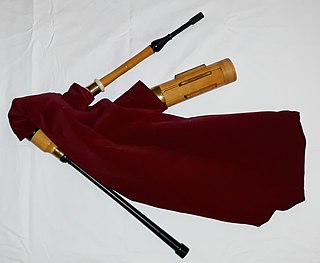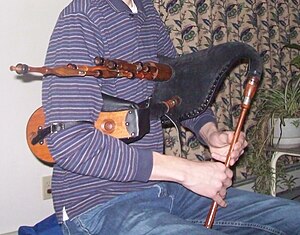
Bagpipes are a woodwind instrument using enclosed reeds fed from a constant reservoir of air in the form of a bag. The Great Highland bagpipes are well known, but people have played bagpipes for centuries throughout large parts of Europe, Northern Africa, Western Asia, around the Persian Gulf and northern parts of South Asia.

The uilleann pipes are the characteristic national bagpipe of Ireland. Earlier known in English as "union pipes", their current name is a partial translation of the Irish language terms píobaí uilleann, from their method of inflation. There is no historical record of the name or use of the term uilleann pipes before the 20th century. It was an invention of Grattan Flood and the name stuck. People mistook the term 'union' to refer to the 1800 Act of Union; this is incorrect as Breandán Breathnach points out that a poem published in 1796 uses the term 'union'.

The chanter is the part of the bagpipe upon which the player creates the melody. It consists of a number of finger-holes, and in its simpler forms looks similar to a recorder. On more elaborate bagpipes, such as the Northumbrian bagpipes or the Uilleann pipes, it also may have a number of keys, to increase the instrument's range and/or the number of keys it can play in. Like the rest of the bagpipe, they are often decorated with a variety of substances, including metal (silver/nickel/gold/brass), bone, ivory, or plastic mountings.

The great Highland bagpipe is a type of bagpipe native to Scotland, and the Scottish analogue to the great Irish warpipes. It has acquired widespread recognition through its usage in the British military and in pipe bands throughout the world.

The border pipes are a type of bagpipe related to the Scottish Great Highland Bagpipe. It is perhaps confusable with the Scottish smallpipe, although it is a quite different and much older instrument. Although most modern Border pipes are closely modelled on similar historic instruments, the modern Scottish smallpipes are a modern reinvention, inspired by historic instruments but largely based on Northumbrian smallpipes in their construction.

The Northumbrian smallpipes are bellows-blown bagpipes from North East England, where they have been an important factor in the local musical culture for more than 250 years. The family of the Duke of Northumberland have had an official piper for over 250 years. The Northumbrian Pipers' Society was founded in 1928, to encourage the playing of the instrument and its music; Although there were so few players at times during the last century that some feared the tradition would die out, there are many players and makers of the instrument nowadays, and the Society has played a large role in this revival. In more recent times the Mayor of Gateshead and the Lord Mayor of Newcastle have both established a tradition of appointing official Northumbrian pipers.
Here Northumbria is defined as Northumberland, the northernmost county of England, and County Durham. According to 'World Music: The Rough Guide', "nowhere is the English living tradition more in evidence than the border lands of Northumbria, the one part of England to rival the counties of the west of Ireland for a rich unbroken tradition. The region is particularly noted for its tradition of border ballads, the Northumbrian smallpipes and also a strong fiddle tradition in the region that was already well established in the 1690s. Northumbrian music is characterised by considerable influence from other regions, particularly southern Scotland and other parts of the north of England, as well as Irish immigrants.

The pastoral pipe was a bellows-blown bagpipe, widely recognised as the forerunner and ancestor of the 19th-century union pipes, which became the uilleann pipes of today. Similar in design and construction, it had a foot joint in order to play a low leading note and plays a two octave chromatic scale. There is a tutor for the "Pastoral or New Bagpipe" by J. Geoghegan, published in London in 1745. It had been considered that Geoghegan had overstated the capabilities of the instrument, but a study on surviving instruments has shown that it did indeed have the range and chromatic possibilities which he claimed.
The Brian Boru bagpipe was invented and patented in 1908 by Henry Starck, an instrument maker, in London, in consultation with William O'Duane. The name was chosen in honour of the Irish king Brian Boru (941–1014), though this bagpipe is not a recreation of any pipes that were played at the time of his reign.
This article defines a number of terms that are exclusive, or whose meaning is exclusive, to piping and pipers.

The William Dixon manuscript, written down between 1733 and 1738 in Northumberland, is the oldest known manuscript of pipe music from the British Isles, and the most important source of music for the Border pipes. It is currently located in the A.K. Bell Library, Perth, Scotland. Little is known of William Dixon's biography, except what has been learned from this manuscript, and from parish records in Northumberland.
John Peacock was one of the finest Northumbrian smallpipers of his age, and probably a fiddler also, and the last of the Newcastle Waits. He studied the smallpipes with Old William Lamshaw, of Morpeth, and later with Joseph Turnbull, of Alnwick.
Hugh Robertson (1730–1822) was a Scottish wood and ivory turner and a master crafter of woodwind instruments such as pastoral pipes, union pipes, and great Highland bagpipes.
The Lowland and Border Pipers' Society was formed in the early 1980s, to promote the study and playing of cauld-wind (bellows-blown) bagpipes of Northern England and south-east Scotland, such as the Scottish smallpipes, pastoral pipes, and border pipes. The organisation holds events and competitions, supplies instructional materials, and publishes a journal, Common Stock. The title of the journal refers to the array of drones on Lowland bagpipes, which are grouped together in a "common stock" rather than separately attached to the bag, such as on the Great Highland bagpipe. The society has played a key role in the success of the revival of the bellows bagpipe traditions of Scotland.
John Dunn was a noted pipemaker, or maker of bagpipes. Born in Newcastle upon Tyne, England, Dunn was a cabinet maker by profession, initially a junior partner with George Brummell. In the trade directories, he also appears in his own right as a turner and a plumb maker and turner. His address was Bell's Court, off Pilgrim Street. He was buried on 6 February 1820 in St. John's, Newcastle. His father may have been one John Dunn of Longhorsley; if so, he was born on 3 September 1764. He should not be confused with one M. Dunn, the maker of several surviving sets of Union pipes.
It is unclear whether Lincolnshire bagpipes refer to a specific type of pipes native to Lincolnshire, England, or to the popularity of a more general form of pipes in the region. Written records of bagpipes being associated with Lincolnshire date back to 1407, but it is difficult to find certain proof that any regional variation of the bagpipe existed which was peculiar to Lincolnshire. Despite the lack of evidence for a uniquely local instrument, it is clear that the bagpipe was enjoyed by the people of Lincolnshire.
Colin Ross was an English folk musician who played fiddle and Northumbrian smallpipes. He was a noted maker of Northumbrian smallpipes, border pipes and Scottish smallpipes, and one of the inventors of the modern Scottish smallpipes.

Irish warpipes are an Irish analogue of the Scottish Great Highland Bagpipe. "Warpipes" is originally an English term. The first use of the Gaelic term in Ireland was recorded in a poem by Seán Ó Neachtain, in which the bagpipes are referred to as píb mhór.

Shuttle pipes are a type of bagpipes which derive their name from the drones used to produce the harmony. Rather than the long tube-like drones of most bagpipes, shuttle pipes use a shuttle drone, a cylindrical chamber enclosing a series of folded drone tubes, each terminating in a slot covered by a sliding "shuttle" which can be adjusted to lengthen or shorten the distance traveled by air moving through the tube, thus flattening or sharpening the pitch of the note produced.










